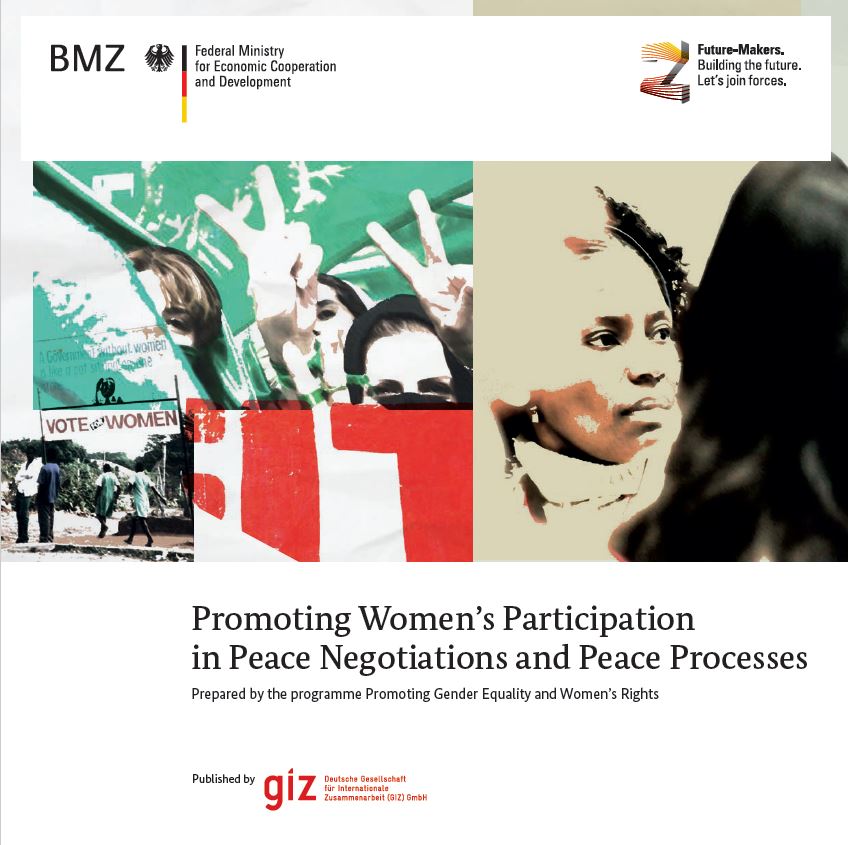Source: European Union Prepared by the programme Promoting Gender Equality and Women’s Rights
“Recognizing that the promotion and empowerment of women and that support for women’s organizations and networks are essential in the consolidation of peace to promote the equal and full participation of women […] and encouraging Member States, donors, and civil society, including non-governmental organizations, to provide support in this respect.” (UNSCR 1888)
Background to and general context of the GIZ toolkit
In 2000, the landmark UN Security Council Resolution 1325 (UNSCR 1325) on Women, Peace and
Security called for the increased participation of women in peace processes and in all peacebuildingrelated
activities. To implement UNSCR 1325, the UN Secretary called upon all UN member states to
develop national actions plans (NAPs) outlining specific lines of national activity.
As of February 2013, nearly 40 such NAPs have been put in place. One of these is the German
Government’s NAP, published in December 2012, that makes UNSCR 1325 a cross-cutting issue for
German foreign defence and development policy (Bundesregierung 2012, p. 2) and aims to provide a
coherent and comprehensive approach and strategy for implementing UNSCR 1325.
The main focus of the German NAP is the participation of women in crisis prevention, peacemaking
and peacebuilding. Its four main aims are:
• Increased involvement of women in national,regional and international institutions and
mechanisms aimed at preventing and managing conflicts;
• A high awareness level regarding gender-specific issues among staff participating in conflict
prevention, conflict management and post-conflict peacebuilding;
• Heightened and appropriate attention to gender perspectives and the participation of women in
the negotiation and implementation of peace agreements;
• Heightened and appropriate attention to the needs of women in the planning and carrying out
of disarmament, demobilisation and reintegration activities (DDR)
With regard to gender-based violence (GBV), the German NAP targets the:
• effective protection of women and girls from human rights violations;
• effective protection of women and girls from gender-based violence during violent conflicts;
• effective prosecution of gender-based violence against women and girls.
The German NAP stresses civil society’s role in developing and implementing the NAP. It also refers
to and supports initiatives that bring men on board with combating and rejecting gender-based
violence (Bundesregierung 2012, pp. 3 and 7).
Table of contents
ABBREVIATIONS
Acknowledgements
Introduction
Background to and general context of the GIZ toolkit Methodology
Main questions and underlying assumptions
Who the toolkit is for
General outline
I. Women’s access to and participation in official peace processes 1. Obstacles to women’s access and participation 2. Opportunities for women’s access and participation 3. Lessons learned and best practices in women’s access and participation 4. Recommendations for German and international development agencies on women’s access to and participation in official processes
II. Women’s influence on the dynamics of peace negotiations 1. Obstacles to securing women’s influence on peace negotiations 2. Opportunities for securing women’s influence on peace negotiations 3. Lessons learned and best practices in securing women’s influence on peace negotiations 4. Recommendations for German and international development agencies on securing women’s influence on peace negotiations
III. Implementing gender-sensitive provisions of peace agreements or demands for gender equality in the post-settlement phase 1. Obstacles to implementing gender-sensitive provisions or demands for gender equality 2. Opportunities for implementing gender-sensitive provisions or demands for gender equality 3. Lessons learned and best practices in implementing gender-sensitive provisions or demands for gender equality 4. Recommendations for German and international development agencies on implementing gender-sensitive provisions or demands for gender equality
Conclusion
Annex: Annex I Conflict Briefings Annex II Important frameworks on Women, Peace and Security Annex III Important online resources Annex IV Selected bibliography
DOWNLOAD: 2014-05-08_toolkit_promoting-womens-participation-peace-neg_en


